How to get rid of tree stump without uprooting using chemicals

Every gardener periodically needs to remove tree. The reasons for this may be different, but problems with the roots remaining in the soil will definitely arise.
The task is significantly complicated by the fact that, as a rule, it is not possible to organize the access of special equipment in the conditions of a holiday village; physical removal is not within the capabilities of every owner or owner of a country plot. Naturally, the question arises of how to get rid of a tree stump without uprooting it. How complex and costly this process is should be considered in more detail.
Content:
- Choosing the best option for removing a tree stump
- In what cases is it possible to use special equipment?
- Manual uprooting - pros and cons
- Chemical removal of tree roots
- How to burn out a stump using saltpeter
- How to remove stumps with urea, what are the advantages
- How to get rid of tree stump without uprooting, using table salt
- Instead of uprooting we use herbicides
- Non-standard, but quite effective options
- Some useful tips
Choosing the best option for stump removal
The part of the trunk remaining after cutting down the tree and root, if desired, you can not remove them; they can serve as an unusual attractive element of the decor of the site.
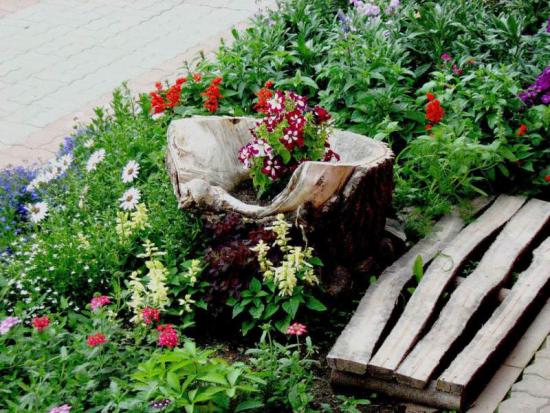
In particular, as a support for climbing plants, they can be used to make a decorative table or bench, other, no less original options are possible. The choice is often dictated by the design features of the garden or the entire site.
Landscape designers generally recommend not getting rid of stumps, but collecting the most attractive specimens of them and creating rutaria, i.e. gardens roots. If you approach this option with imagination, then a composition created on the basis of not uprooted remains of cut down trees can become the highlight of a landscape garden.

But if the old tree was infected pests, or diseases, then stump removal is a mandatory procedure. Even a small part of it left in the ground can become a source of infection of all plants on the site.
In a small garden, leaving stumps from old trees is also not rational - they will take up too much space.
In what cases is it possible to use special equipment?
Which removal methods are best to resort to is not an easy question. Of course, if the one being deleted tree you can attract specialists and equipment, but you can lean towards this option only if the plot is of a substantial size and there are no buildings or young plantings on it.

From a cost point of view, this option is only justified if you need to remove a lot of trees or stumps. Typically, this method is resorted to if it is planned to develop a plot previously allocated for growing fruit or ornamental trees.
Manual uprooting - pros and cons
Before deciding to uproot a stump manually, you should evaluate your strength and acquire auxiliary tools.The use of this method will not require financial costs; the work can be completed within one or two days, but it will require considerable physical effort.
Strong arguments in favor of manual uprooting include:
- very limited space for action
- close placement vegetable beds, buildings, trees
- uprooting young trees whose roots have not yet grown very much
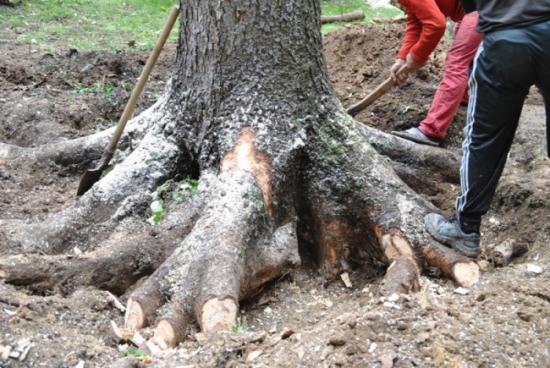
There are times when special equipment cannot be fitted, chemicals or fire cannot be used, and manual labor will have to be used. But this method is considered outdated today.
Under certain conditions, experts still recommend using chemical reagents to remove stumps.
Chemical removal of tree roots
The point is that wood, under the influence of chemically active substances, quickly turns into dust, which greatly simplifies the process of cleaning the area from stumps.
The following chemical agents are used:
- salt
- saltpeter
- urea
It is recommended to plan planting in place of the removed stumps no earlier than in a couple of years; they will be needed to completely destroy the wood.
How to burn out a stump using saltpeter
Sodium or potassium can be used as a chemical reagent saltpeter Their penetration deep into the wood will lead to the complete destruction of the tree’s crown system, regardless of its size. It should be taken into account that saltpeter will ultimately penetrate deep into the soil along the root and accumulate in it.
The task is to drill several holes on the surface of the hemp, 35-40 cm deep and 1 cm in diameter. At least 100 g is poured into each of them saltpeter. Next, add water.
It is best to close the holes tightly with wooden plugs so that the saltpeter is not washed out by rain. If this procedure is carried out in the summer, then in the spring of next year you can start burning the stump.
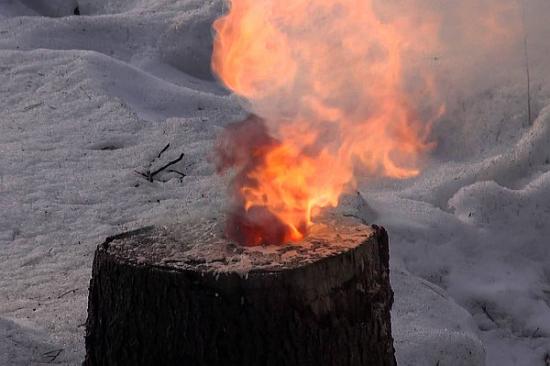
With the onset of heat, the holes are opened and gasoline is poured into them, then set on fire. Be sure to follow safety precautions!
Since nitrate releases oxygen as a result of exposure to high temperatures, the flame actively spreads in the soil, and even small roots burn.
We should not forget that it is strictly forbidden to use saltpeter for uprooting stumps in peat soils. Such actions may cause a fire!
The advantages of the method include:
- pretty quick results
- shoots do not appear from the roots
- minimal labor costs
The costs will not be that much; you just need to purchase saltpeter at a specialized gardening store.
How to remove stumps with urea, what are the advantages
The work is performed in the same way as when burning with saltpeter. More holes will make the chemical work faster. This method is not associated with danger; there is no need to set fire to the stump. It will simply decompose from exposure to urea. Sprouts will not appear from the root.
Such an object can be covered with soil and a tree or bushes planted nearby. Decayed wood and urea, accumulated in the ground, will be excellent sources of nutrition for them.
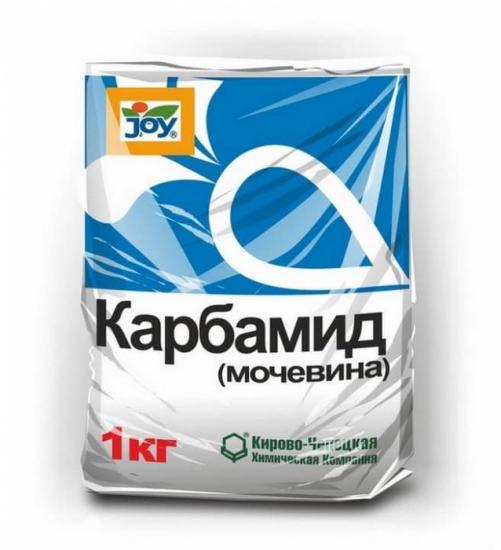
The advantages of using urea are obvious:
- no brute force required
- the soil is not contaminated with chemicals
- the remnants of the root system are completely removed
The option of removing stumps with urea can be used on any type of soil, including peat.
How to get rid of tree stump without uprooting, using table salt
To destroy tree roots, it is not necessary to buy special chemicals; you can use those products that are used in household use. Let's figure out how to turn a stump into dust using ordinary salt.
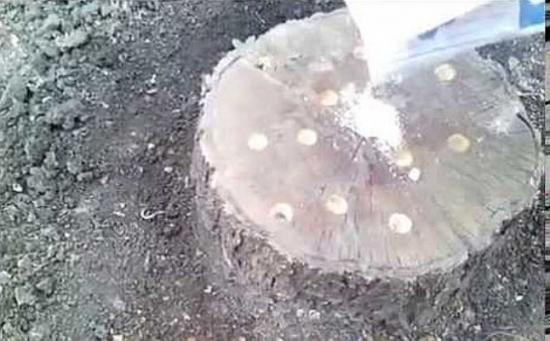
The procedure is as follows:
- in the fall you need to drill holes in the stump and add salt; one stump will require up to 300 g of salt
- then add as much water as you can into the holes
- cover the stump with soil on top
The decomposition process will take about a year; a stump treated in the spring will be completely decomposed by next spring. We should not forget that removing stumps with salt is a process that causes clogging of the soil; for several years it is impossible to plant in the place of the former stump vegetable crops or flowers.
The positive aspects include the low cost of the method and the ease of its implementation, but the negative aspects will be:
- pollution soil
- long period of wood decomposition
Instead of uprooting we use herbicides
If the stump is of impressive size, you can attempt to remove it using herbicides, let’s take the most popular ones Roundup or Tornado.
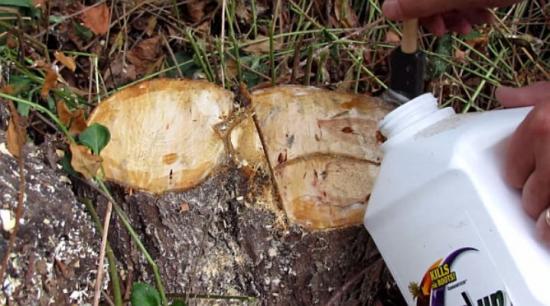
The operating procedure is as follows:
- the top of the stump is cut down at such a height that a fresh cut is obtained
- the resulting surface is poured herbicide
- the entire stump is tightly wrapped with plastic wrap
You can begin removing the decomposed rhizome next summer, i.e. in about a year.
The method is quite simple and effective, the costs will not be significant for the purchase of herbicide and plastic film.
Non-standard, but quite effective options
When discussing options for turning a stump into dust, you should remember other methods; they are not used so often, but they give good results.
Using water
You can even get rid of an old stump with water. Before the start of winter frost The wood is watered abundantly. Under the influence of negative temperatures, the water that has soaked the wood crystallizes, increases in volume and tears the stump from the inside.
By spring, the stump usually decomposes to such an extent that it is easily pulled out from the ground, with minimal effort being applied.
The second method, using water, will require digging a hole about half a meter away from the stump to be removed. With good pressure, water is supplied from the hose to the root, quickly washing it out of the soil. The dirt flows into a hole prepared in advance.
As a result of such actions, the roots will be cleared of the soil. Next, you just need to chop them with an ax and pull the remains of the wood to the surface.
Turning a stump into a growing area mushrooms
Cuts are made in the remains of the tree trunk and filled with spores of honey mushrooms or oyster mushrooms. After abundant watering of the stump, it is wrapped in film for the whole winter.
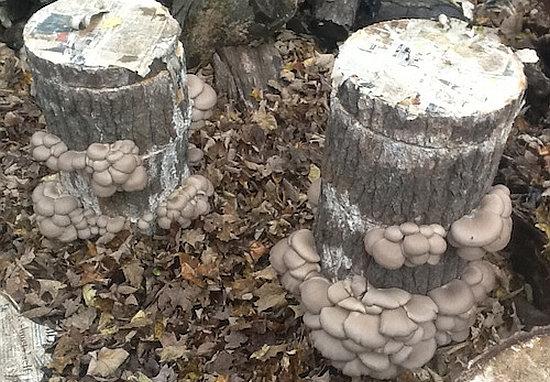
It will be possible to reap a good harvest in the spring mushrooms. You can use stumps in this way for 4-5 years, during which time they will completely dry off. They can then be removed from the soil without much effort.
Using this option, you can get double benefits, and without any special financial expenses.
We use waste machine oil
Let's look at how to destroy a stump using mining. The stump will first need to be dug to a depth of 15-20 cm.
Remove the bark from the trunk, grease it with mining and attach it back to the trunk, then sprinkle it with soil.
It may take several years to destroy a stump using this method.
We grow new trees in place of old stumps
Experienced gardeners use this method to grow young trees in place of old ones. Using a chainsaw, the stump is cut at ground level, a depression is made in the trunk, complex mineral fertilizers are applied and planted seedling.
As the roots of the young plant develop, they destroy rotten wood and obtain fertilizer from it.
In just a few years, we get a strong, new tree in place of the old plant.
Using a chainsaw
Using the tool remove all available fragments rhizomes. The method is cheap and not complicated, but not very effective and can be used as a temporary measure. Usually, soon after such work, young growth appears.
Stump grinder
This special tool is capable of destroying wood to a depth of 40 cm, while the roots of nearby plants are not damaged. The work is done quickly.
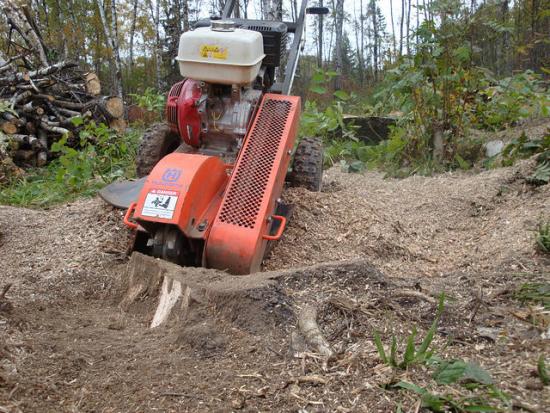
The device itself is small in size. Wood is crushed by milling. The root crusher is more difficult to use if the stumps have a very large diameter.
But with such obvious advantages, the device has no less significant disadvantages - a very high cost, even renting such a unit is not a cheap pleasure.
If buying a chopper is a done deal, then you should contact stores that specialize in selling gas mowers, chainsaws and other similar equipment, or place an order online.
Some useful tips
Before you start work, you should analyze the situation and choose the cheapest method with the least labor costs.
If the site is intended for development, it is rational to use saltpeter; it acts faster than urea. On the territory of future beds or flower beds It is better to use urea, because saltpeter will burn out all the vegetation around the stump. The negative effect of using urea in garden conditions is minimal.
To facilitate the process of removing rhizomes, it is sometimes rational to use a winch. But during work you should be extremely careful; injury can be caused by a suddenly bursting cable or rope, or by a stump suddenly jumping out of the ground. It is better to stay away from the places where its flight path is possible.

If an ax is used in the work, other participants in the process should be at a safe distance.
When working with chemicals, you should not abandon the use of personal protective equipment and protective clothing; it is especially important to protect your eyes and hands from the substances used. Moreover, hand protection is important not only when working with saltpeter; urea should also not be scattered with unprotected hands.
Regarding the time of work, we can recommend the following:
The optimal time for applying chemical reagents is autumn or late summer, when the fruits from nearby plants have already been harvested. Who will eat vegetablesthat have accumulated excessive amounts of nitrates or other equally dangerous chemicals?
It is very difficult to give a definite answer which method of stump removal is better. If mechanical removal is the fastest, then it is also the most costly; the use of special equipment is fraught with the need to restore order throughout the entire area; in addition, it is generally impossible to use it in a small area.
When choosing a method, be sure to take into account the specific circumstances and characteristics of the site.
We invite you to watch an interesting video about how to remove stumps using saltpeter:


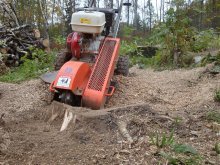
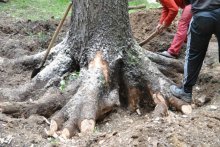
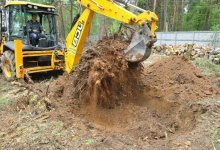


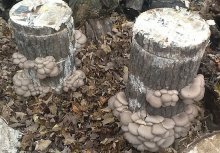
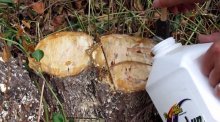
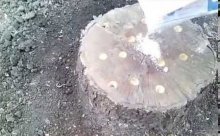

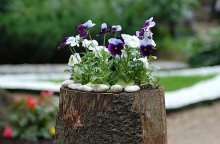


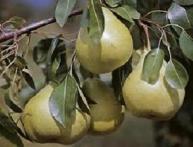


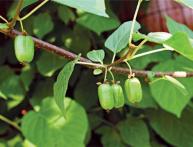
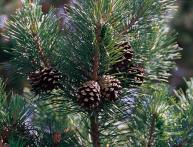

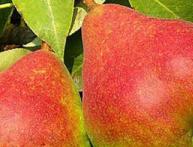
Comments
If you just water a tree with table salt, will its roots disappear or not? A huge poplar grew under our windows, no matter how much we watered it, nothing happened until the utility services cut it down.
I also have such a stump. I built a small bed with flowers in it. I can’t handle it myself, I don’t even dare. Well, I can say that if you also surround it with stones, then you will get quite an alpine slide, if the space allows it, of course.
We only burn stumps on our site and this is very effective, since not only the stump itself burns, but also the roots that are close to the stump from the ground. And this procedure does not cost anything financially.
I had to remove a stump from a bush. It turned out to be easy to deal with. I cut it down to the very root, then painted over what was visible with enamel, and then covered it with earth. And that’s it, no growth appeared from it.